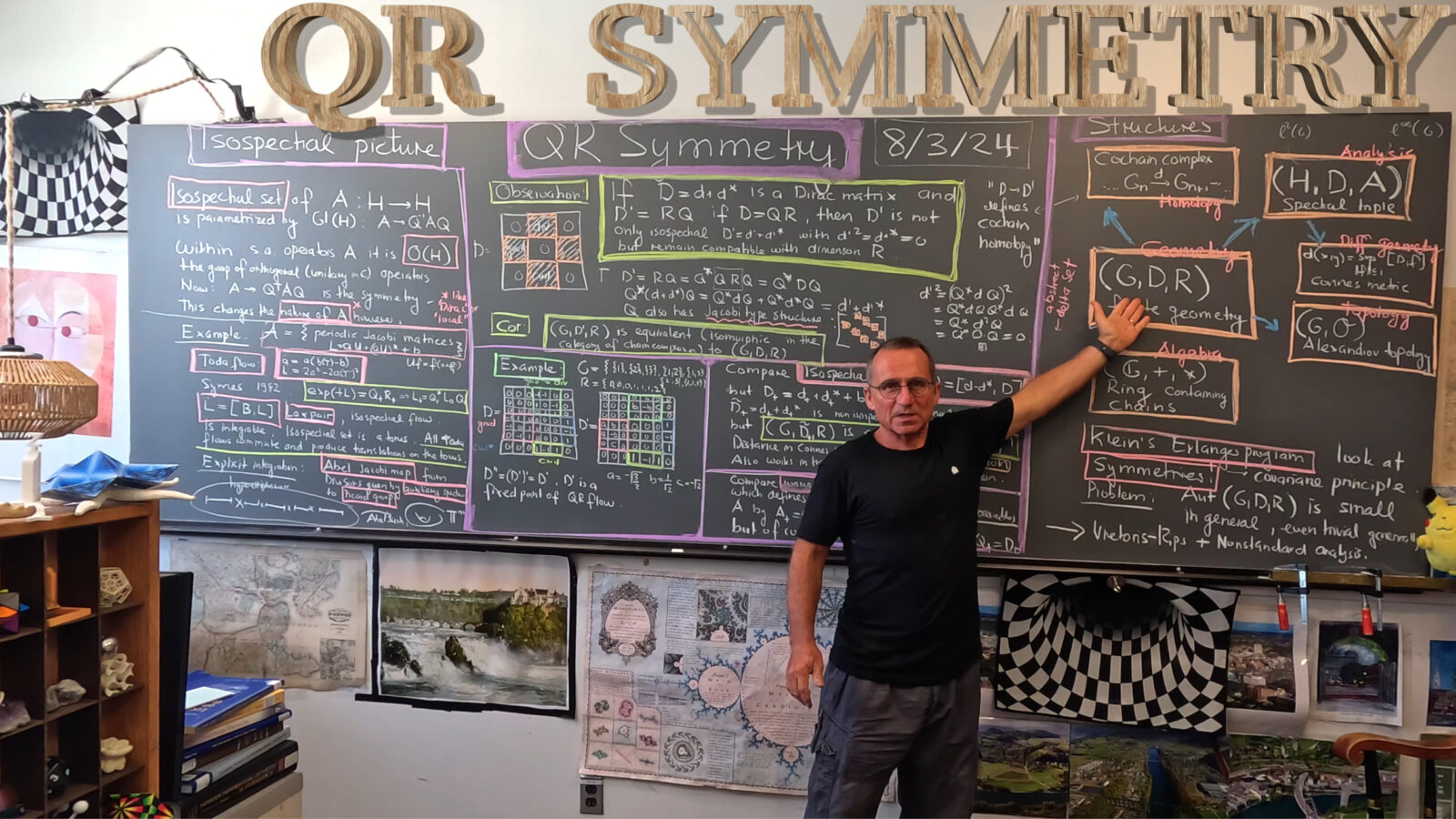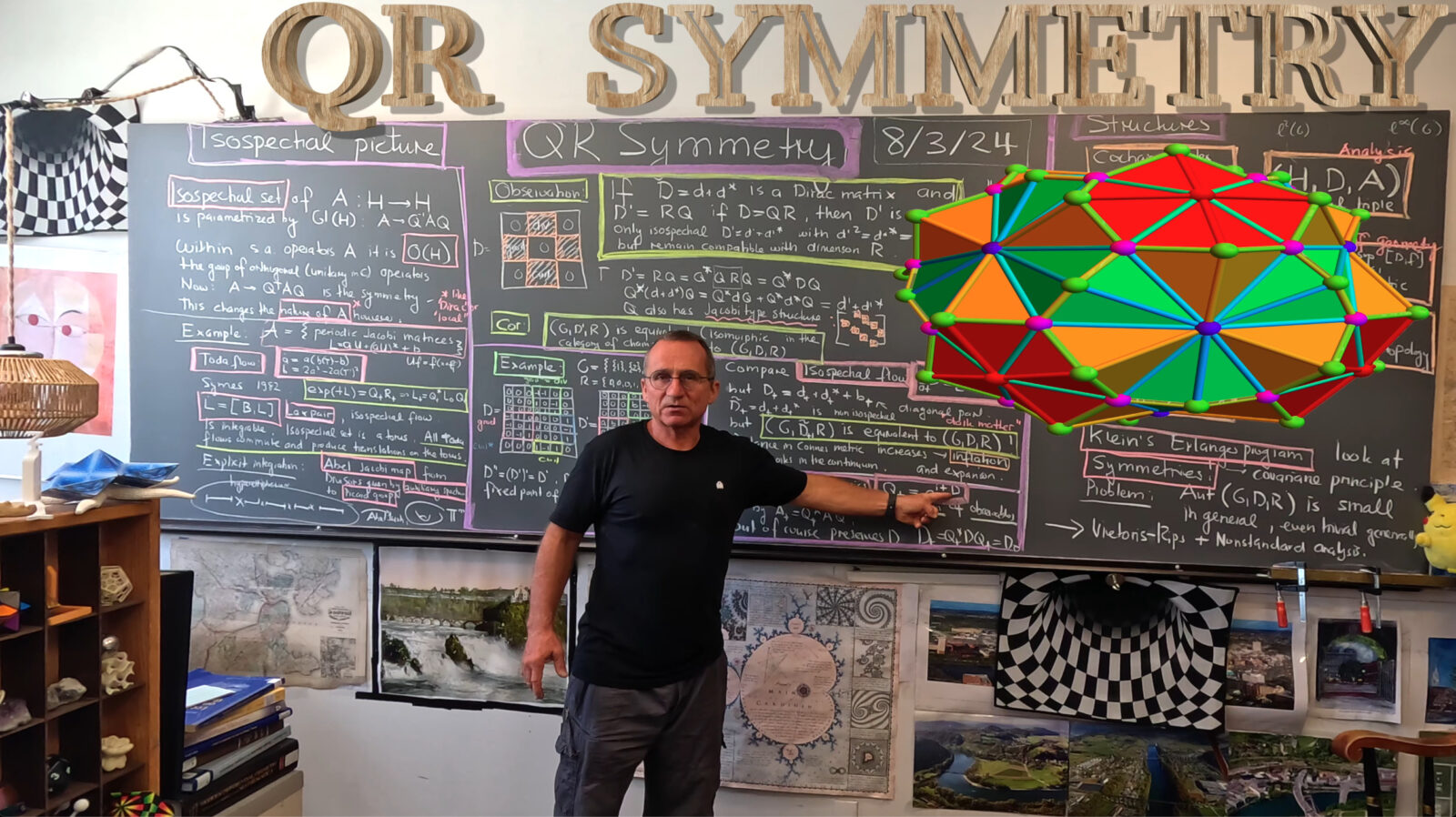A discrete geometry does not have a lot of symmetry as the automorphism group is in general empty. The isospectral set of the Laplacian or Dirac matrix is large enough however. Note that when dealing with a specific class of operators like Dirac matrices, then not all isospectral matrices qualify. In the case of Dirac matrices, one wants the transformed exterior derivative to be produce a new cochain complex that is chain homotop to the old one. If d’ is the deformed exterior derivative of d, then we still want d to map the space of k-forms to the space of (k+1) forms
. The symmetry is therefore not the group of unitary transformations in
. . During the Pandemic years, I had experimented with Vietoris-Rips ideas together with non-standard analysis: if you have a geometric space like a compact Riemannian manifold M, chose n points at random in M, then chose a threshold h below which two points are connected with each other. One obtain then a in general messy finite simple graph which however from a homotopy point of view is equivalent to M, as long as the number of points n and the threshold h are chosen large rsp.small enough. What happens if one has a continuous symmetry group acting on the space, that one just also discretizes this looks at all points and translated points. Now one has a structure on which the non-standard but finite symmetry group part can act. This is what happens in reality: we only can observe finitely many points and finitely many transformations. All this is described by a finite set. There are of course drawbacks with such an approach and one of them is that one rather deals with a numerical method.
The periodic Toda systems, , where one knows the isospectral set has first been investigated in the 1960ies. Mark Kac (1914-1984) and Pierre van Van Moerbeke (1944-) have found the solution of the Toda system in 1975. Hermann Flaschka (1945-2021) [who had been the head of the math department in the university of Arizona, when I was there from 1997/1998] and Michel Henon (1931-2013). The Toda system
is a discrete analog of the KdV system and equivalent to the Kac-van Moerbeke system
. This is related to the fact that we can factor the Laplacian
as
where
is a new Jacobi matrix. In my thesis, I iterated this factorization and got so operators with spectra on Julia sets. The Toda system , a discretisation of KdV was found by Morikazu Toda (1917-2010) in 1967. It is equivalent to
, Hamiltonian system describing the motion of a chain of masses coupled with an exponential potential. Nonlinear integrable systems are exciting because of soliton solutions first observed in 1834 by John Scott Russell and later called so by Norman Zabusky (1929-2018) and Martin Kruskal (1925-2006) who was a student of Richard Courant (1888-1972). Courant had a daughter (Gertrude (1922-2014) ) who married Juergen Moser (1928-1999). By the way, I learned the “integrable stuff” from the excellent lectures notes [PDF scan] of Moser who gave a course at ETH in the summer of 1984 (which was the time, when ai spend the first 4 months in the Swiss military driving M109 tanks. The lecture notes had been written by Andy Stirnemann who had been a CA of mine in an analysis courses (he must have been a senior them) and later (after he had worked in the industry for some time) came back and did his PhD with Oscar Lanford III on renormalization of golden circles. Andy was one of the grad school buddies and also close to Frank Josellis.
In the talk, I mention the QR story. The question of how large the symmetry group of a given delta set (G,D,R) is, is very interesting. We look for all the Q’s for which Q* D Q defines a chain equivalent delta set. The obvious guess when looking at the Toda story is that it is a finite dimensional torus where the dimension is the number of gaps in the spectrum of L. The divisors of the auxiliary spectrum given by some Dirichlet conditions should via an Abel-Jacobi map then produce points on this torus. This is the naive picture extrapolating from the known structures. For me here, it was just an interesing aspect of symmetry we can get. It is related to my work from the summer of 2013 about integrable evolution in geometry (see also Isospectral deformation of the Dirac operator) which I still consinder a very interesting system. I remember, I had tried then (I was with 50 years still quite naive about the publishing prospects of a “nobody”) to submit that to a physics journal but it did not even make it to a referee. It is an interesting fact however that we can deform a Dirac matrix and get new Dirac matrices
, where
are block diagonal and such that
stays constant. The new exterior derivatives
define a chain homotopy on the geometric structure which in the Connes picture defines an expansion of space. This is very natural and inevitable. If one postulates that the symmetries of (G,D,R) are the isomorphisms in the category of chain homotopies, then it is also from a physical point of view natural that a system can freely move in that symmetry group. We know that from the earliest physics lessons. For classical physics, it does not matter, how a system is placed or rotated in space. The covariance picture tells that the physical laws remain the same. This means with Emmy Noether that we have conservation laws (momentum by translation symmetry, angular momentum by rotation symmetry and energy conservation by time translation symmetry. Now, the same holds also with a finite geometric system. The conserved quantities of course are the eigenvalues of the Laplacian. A system naturally moves in the isospectral set (a rock in space very unlikely does not rotate). This means that any finite geometric space naturally expands. Always! It does not matter in which direction we move, space always expands. This looks counter intuitive but the reason is that if we evolve and forget about the dark matter stuff
(the block diagonal stuff in the Dirac matrix which is only absent at t=0), then we get an equivalent geometry but which is always larger than the geometry at t=0. This idea is a bit hard to swallow and can not be passed through a traditional referee system.














